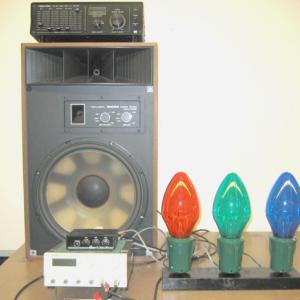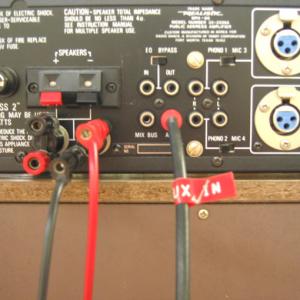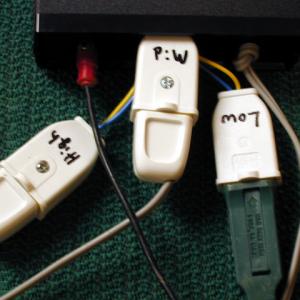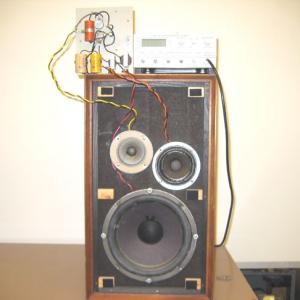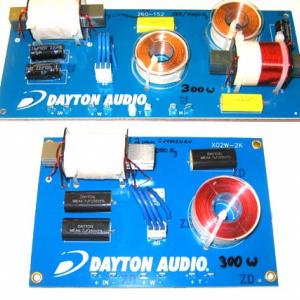College of Liberal Arts & Sciences
3E20.35 - High - Mid - Low Pass Filter/Crossover
See also 3E20.30 in Oscillations and Acoustics and 5L30.36 in Electricity and Magnetism.
Connect one set of the speaker outputs to the sound color organ and the other set to the speaker. Connect the Christmas lights to the sound color organ in any desired color scheme. I like to use red as low, green as mid, and blue as high frequency. As you sweep the frequencies with the wave generator from 0 to 11 KHz, the red, green, and blue should light up when the appropriate frequency ranges appear. The amplifier master volume set at 5 appears to work very well. Some fine tuning of the pot controls on the color organ may be needed to get the appropriate responses. Basically, this is a visual indicator of when a crossover changes frequency ranges.
Real crossovers can be viewed in the large speaker or with the individual units.
- Erik Zavrel and Eric Sharpsteen, "Introducing Filters and Amplifiers Using a Two-Channel Light Organ", TPT, Vol. 53, #8, Nov. 2015, p. 478.
- John E. Peterson, "Hearing by Bone Conduction", TPT, Vol. 17, #8, Nov. 1979, p. 531.
- Lester Dwyer, "Color Organ", TPT, Vol. 9, #1, Jan. 1971, p. 47.
- Jack L. Uretsky, "Comment on 'Phase Transition-Like Behavior in a Low-Pass Filter'", AJP, Vol. 71, #1, Jan. 2003, p. 31', AJP, Vol. 71, #12, Dec. 2003, p. 1320.
- A. Lesne, "Comment on 'Phase Transition-Like Behavior in a Low-Pass Filter', AJP, Vol. 71, #1, Jan. 2003, p. 31", AJP, Vol. 71, #7, July 2003, p. 732.
- H. Krivine, A. Lesne, "Phase Transition-Like Behavior in a Low-Pass Filter", AJP, Vol. 71, #1, Jan. 2003, p. 31.
Disclaimer: These demonstrations are provided only for illustrative use by persons affiliated with The University of Iowa and only under the direction of a trained instructor or physicist. The University of Iowa is not responsible for demonstrations performed by those using their own equipment or who choose to use this reference material for their own purpose. The demonstrations included here are within the public domain and can be found in materials contained in libraries, bookstores, and through electronic sources. Performing all or any portion of any of these demonstrations, with or without revisions not depicted here entails inherent risks. These risks include, without limitation, bodily injury (and possibly death), including risks to health that may be temporary or permanent and that may exacerbate a pre-existing medical condition; and property loss or damage. Anyone performing any part of these demonstrations, even with revisions, knowingly and voluntarily assumes all risks associated with them.
